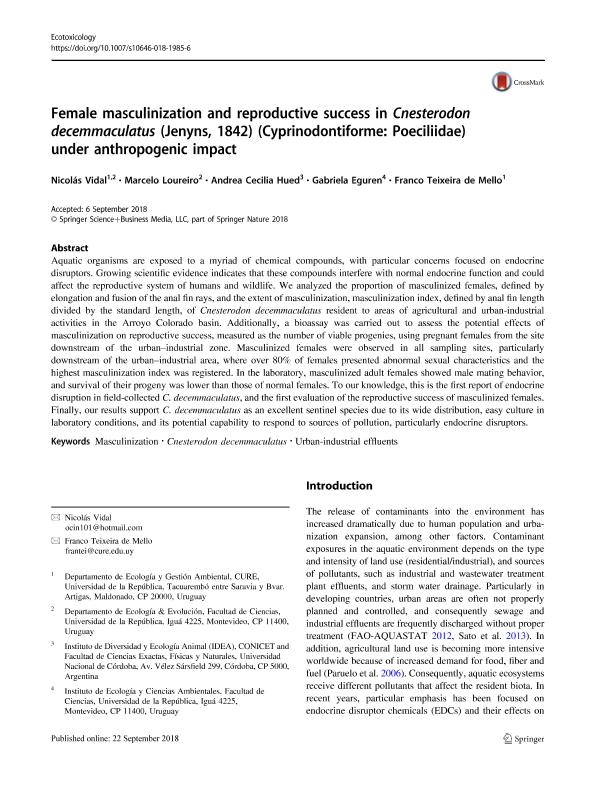Artículo
Female masculinization and reproductive success in Cnesterodon decemmaculatus (Jenyns, 1842) (Cyprinodontiforme: Poeciliidae) under anthropogenic impact
Vidal, Nicolás; Loureiro, Marcelo; Hued, Andrea Cecilia ; Eguren, Gabriela; Teixeira de Mello, Franco
; Eguren, Gabriela; Teixeira de Mello, Franco
 ; Eguren, Gabriela; Teixeira de Mello, Franco
; Eguren, Gabriela; Teixeira de Mello, Franco
Fecha de publicación:
22/12/2018
Editorial:
Springer
Revista:
Ecotoxicology
ISSN:
0963-9292
e-ISSN:
1573-3017
Idioma:
Inglés
Tipo de recurso:
Artículo publicado
Clasificación temática:
Resumen
Aquatic organisms are exposed to a myriad of chemical compounds, with particular concerns focused on endocrine disruptors. Growing scientific evidence indicates that these compounds interfere with normal endocrine function and could affect the reproductive system of humans and wildlife. We analyzed the proportion of masculinized females, defined by elongation and fusion of the anal fin rays, and the extent of masculinization, masculinization index, defined by anal fin length divided by the standard length, of Cnesterodon decemmaculatus resident to areas of agricultural and urban-industrial activities in the Arroyo Colorado basin. Additionally, a bioassay was carried out to assess the potential effects of masculinization on reproductive success, measured as the number of viable progenies, using pregnant females from the site downstream of the urban–industrial zone. Masculinized females were observed in all sampling sites, particularly downstream of the urban–industrial area, where over 80% of females presented abnormal sexual characteristics and the highest masculinization index was registered. In the laboratory, masculinized adult females showed male mating behavior, and survival of their progeny was lower than those of normal females. To our knowledge, this is the first report of endocrine disruption in field-collected C. decemmaculatus, and the first evaluation of the reproductive success of masculinized females. Finally, our results support C. decemmaculatus as an excellent sentinel species due to its wide distribution, easy culture in laboratory conditions, and its potential capability to respond to sources of pollution, particularly endocrine disruptors.
Palabras clave:
CNESTERODON DECEMMACULATUS
,
MASCULINIZATION
,
URBAN-INDUSTRIAL EFFLUENTS
Archivos asociados
Licencia
Identificadores
Colecciones
Articulos(IDEA)
Articulos de INSTITUTO DE DIVERSIDAD Y ECOLOGIA ANIMAL
Articulos de INSTITUTO DE DIVERSIDAD Y ECOLOGIA ANIMAL
Citación
Vidal, Nicolás; Loureiro, Marcelo; Hued, Andrea Cecilia; Eguren, Gabriela; Teixeira de Mello, Franco; Female masculinization and reproductive success in Cnesterodon decemmaculatus (Jenyns, 1842) (Cyprinodontiforme: Poeciliidae) under anthropogenic impact; Springer; Ecotoxicology; 27; 10; 22-12-2018; 1331–1340
Compartir
Altmétricas



